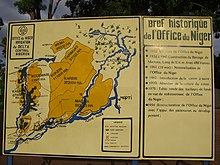Office du Niger
 Sign announcing the Office du Niger near the Markala dam in Mali |
|
| Water resource management overview | |
|---|---|
| Formed | January 5, 1932 |
| Jurisdiction | Niger River in Mali |
| Website | www |

Average flow in m3/s of the Niger River at the Markala Dam
|
The Office du Niger is a semi-autonomous government agency in Mali that administers a large irrigation scheme in the Ségou Region of the country. Water from the Niger River is diverted into a system of canals at the Markala dam 35 kilometres (22 mi) downstream of Ségou. The water is used to irrigate nearly 100,000 hectares (390 sq mi) of the flat alluvial plains to the north and northeast of Markala that form part of the Delta mort. Although the French colonial administration constructed the system to produce cotton for the textile industry, the main agricultural product is now rice. Around 320,000 tons are grown each year representing 40 percent of the total Malian production. Large quantities of sugar cane are also grown in joint ventures between a Chinese company and the Malian state. The irrigation scheme uses 2.7 km3 (0.65 cu mi) of water each year corresponding to around 10 percent of the total flow of the Niger River.
The Niger, and its tributaries, the Sankarani, the Niandan, the Milo and the Tinkisso, rise in Guinea Highlands and the Fouta Djallon nearly 750 kilometres (470 mi) to the southwest of Markala. The climate of both Mali and Guinea is determined by the West African Monsoon with the maximum rainfall occurring in August, but while the annual rainfall in the Guinea Highlands approaches 2,000 mm (79 in), that at Markala is only 600 mm (24 in). The short but relatively intense rainy season produces a surge of water flowing down the river system which in turn leads to the flooding of the Inner Niger Delta. Since the construction of the Sélingué hydroelectric dam on the Sankarani in 1982, some of the flood water has been retained and released later during the dry season.
At the Markala dam, in an average year, the discharge of the Niger River reaches a peak of around 2,800 m3 (99,000 cu ft) in the second half of September but drops to under 120 m3 (4,200 cu ft) in the dry season between February and April. The average discharge is around 800 m3 (28,000 cu ft), but there are large year-to-year variations in the intensity of the monsoon and thus in the water flowing in the river. In a dry year such as 1989, the average discharge was only 539 m3 (19,000 cu ft), while in a wet year such as 1995 the discharge was 1,229 m3 (43,400 cu ft).
...
Wikipedia
